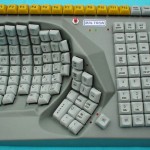Smarter Keyboards
 The argument used to be that you could never change the QWERTY keyboard design because so many people had learned it. In addition the hardware change was too expensive. It seems that this is changing. With modern cell phones using adaptive full screen interfaces the market is ripe for keyboard innovation.
The argument used to be that you could never change the QWERTY keyboard design because so many people had learned it. In addition the hardware change was too expensive. It seems that this is changing. With modern cell phones using adaptive full screen interfaces the market is ripe for keyboard innovation.
While things like the Dvorak layout aren't yet making their way to your iPhone there are a number of interesting keyboard designs and technologies that are being explored across a number of devices.
BlackBerry
Perhaps BlackBerry has fallen out of favor in the mobile community but the recent BB10 preview offers some interesting innovation in the keyboard space.
The keyboard works like normal but also hints words above the letters that they are typing. If a hint word is correct the user can swipe up to toss the word into the text message.
This is a clever idea as it puts the auto-completed words right at your fingertips in the location that you're already looking to type the word. Clever.
Android
The idea of tossing words into the editor is new however the idea of predictive text has been around for a few years. Android ICS has this feature and third party keyboards for Android such as SwiftKey also have this functionality. In the android designs the predictive text is shown above the keyboard area.
Predictive text is interesting but I worry that it biases people in unusual ways. Word choice may be selected even when it doesn't match the original thoughts you were thinking. This subtle shift in word choices may impact the meaning of the intended message.
You start typing "I thought" but the keyboard suggests "I think." The typer may select the choice as close enough. This actually changed the meaning. The former was perhaps a question or assumption the latter was a declarative statement. In the BlackBerry design you don't have this problem as much because "Think" would hover over the I and "Thought" would hover over the O.
Another interesting innovation on Android has been a technology called Swype. The idea with swype is that you don't lift your finger between letters as you write a word. This creates gestures and shapes on the screen surface that draw out words.
It's a clever idea that mixes the drawing and typing. The finger trail it leaves behind is interesting but probably not useful to the user.
The trail can cause an occlusion problem where the trail can cover up the letters you're trying to use.
Apple
 Not to be outdone Apple is also doing some interesting things in the keyboard space. Apple's design elegantly deals with occlusion problems, aka the obstruction of the keyboard by your fat fingers.
Not to be outdone Apple is also doing some interesting things in the keyboard space. Apple's design elegantly deals with occlusion problems, aka the obstruction of the keyboard by your fat fingers.
When you tap on a letter a larger letter pops up letting you visually confirm that you've hit the right letter. If you keep that letter held down additional options are made available. Try holding down some buttons and you may be surprised by some of the other options.
Voice
Both Google and Apple are exploring voice on the keyboard. It's certainly a time saver if you're alone and can use voice. People seem to feel conspicuous talking into their phones and the dictation, while good, isn't good enough to be used reliably.
Th future
The future of input and keyboards is bright for mobile devices but it's still held back on desktop computers. I have hoped to see desktop adaptive input incorporate this since 2007. There's a ton of opportunity to change the way we type, think, create.


